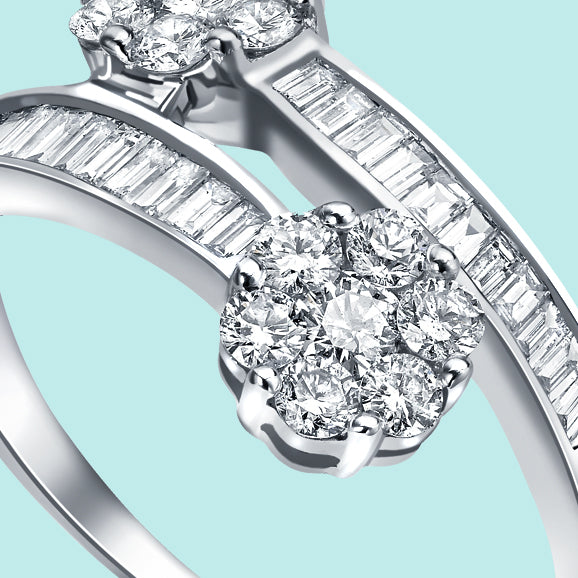
Baguette Cut Diamond Explained
Baguette cut diamonds are rectangular with a step-cut of the same type as found on emerald shape diamonds. The name comes from the long thin French Stick bread. Initially popular during the Art Deco period of the 1920s and 30s and so have an elegant association with the past.
Baguettes are usually cut with 24 facets and are much less brilliant than round diamonds. As a result of the lesser brilliance, they tend to show off colour more than many other diamond shapes so care should be taken when choosing the colour grade. Baguettes have excellent clarity due to their large table facet (the large flat top facet).
Because most baguettes are small and have straight sides that can be set flush, they are often used to accent larger gems. Some baguettes are cut in a tapered shape enabling them to be set in curves for pieces such as earrings.

How To Choose The Best Baguette Diamond For you?
Clarity Is A Must!
Baguettes are pleasing for their straight lines and simplicity, but this simplicity, which extends to the low number facets makes them very sensitive to clarity. Even the smallest flaws, such as black carbon crystals or feathering, will be immediately apparent. Choosing a clarity grade of VS2 or better is an essential choice. Even when a high clarity grade is selected, careful inspection is needed to ensure that any flaws present are not easily visible.

Colour Is Easily Seen
The simple appearance of the baguette shows off any colour tints. Unless you buy a G or H (or better) colour grade, you will probably be able to see a yellow shading.
Careful matching between your baguettes and a central diamond is essential to ensure that the appearance of the finished jewellery is uniform across the whole piece. The centre stone doesn't need to be the same colour grade but, as a rule of thumb, stick within two colour and clarity grades.

Cut Quality And Baguette Diamonds
Baguettes are not very brilliant, so there is little that cutting and polishing can do to make these stones sparkle or appear more brilliant. With baguettes, you are looking for the lustre of the gem, not the sparkle.
The most important point to look out for is the symmetry of the gems and consistency between each baguette in any piece of jewellery. You need each stone to fit with its neighbours perfectly with no gaps or signs of misalignment.
To maximise the perceived size and thus the value of your baguettes, choose relatively thin diamonds. There is no benefit to the brilliance of a thicker gem and, carat for carat, a thinner baguette will look more substantial than a thicker one.

Setting Your Baguettes
Typically, baguettes use a channel setting. This setting style looks like a pave setting but with thicker metal. This design protects the delicate edges of the diamonds. Because there are no prongs, there is no risk of snagging any clothes against which it might rub.
Occasionally a prong design is used when a large baguette is a centrepiece.
Baguettes are usually less expensive, carat for carat than other diamond shapes so can be a great value when a large diamond is used. The drawbacks of a large baguette are a lack of brilliance and sparkle in comparison to most other diamond shapes.
The elegant shape looks stunning when small baguette diamonds are used to accentuate a larger diamond.